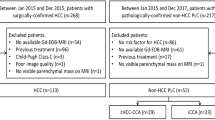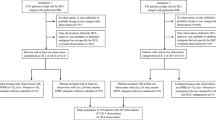Abstract
Objectives
To evaluate the diagnostic performance of the LI-RADS (v2014) on gadoxetate-enhanced MRI prospectively applied in actual practice.
Methods
We retrospectively reviewed the prospectively written radiology reports of 143 treatment-naïve at-risk patients who underwent gadoxetate-enhanced liver MRI from January to December 2014, and identified 202 hepatic observations categorized using the LI-RADS. The diagnostic performances of LI-RADS categories for hepatocellular carcinoma (HCC) and hepatic malignancy were calculated.
Results
Twenty (69.0 %) of 29 LR-4, 73 (97.3 %) of 75 LR-5, and all of five (100 %) LR-5V observations were HCCs. The remaining two (2.7 %) LR-5 observations were combined hepatocellular-cholangiocarcinomas, while 10 (76.9 %) of 13 LR-M observations were HCCs. The sensitivity and specificity of LR-5/5V for HCC were 60.5 % and 97.3 %, respectively. Including LR-M in the diagnostic criteria for HCC increased sensitivity (68.2 %, p = 0.002) but decreased specificity without statistical significance (93.2 %, p = 0.154). LR-5/5V/M yielded sensitivity of 68.9 % and specificity of 100.0 % for hepatic malignancy.
Conclusions
LI-RADS v2014 was successfully applied on gadoxetate-enhanced MRI in clinical practice. LR-5/5V was the most specific diagnostic measure for HCC, but most LR-M observations were HCCs and a considerable portion of non-HCC malignancies were categorized as LR-4 or LR-5.
Key Points
• LR-5/5V provided a highly specific diagnosis for HCC.
• Half of non-HCC malignancies were categorized as LR-4 or LR-5.
• The majority of LR-M observations were finally diagnosed as HCCs.
• More sensitive diagnosis of HCC was feasible with LR-5/5V/M on gadoxetate-enhanced MRI.
• Observations in either LR-5/5V or LR-M categories were definitely malignant.




Similar content being viewed by others
Abbreviations
- HCC:
-
Hepatocellular carcinoma
- LI-RADS:
-
Liver Imaging Reporting and Data System
- LR:
-
LI-RADS category
- MRI:
-
Magnetic resonance imaging
References
Mitchell DG, Bruix J, Sherman M, Sirlin CB (2015) LI-RADS (Liver Imaging Reporting and Data System): summary, discussion, and consensus of the LI-RADS Management Working Group and future directions. Hepatology 61:1056–1065
American College of Radiology (2017) Liver Imaging reporting and data system version 2017. Available via http://www.acr.org/Quality-Safety/Resources/LIRADS. Accessed 1 Jul 2017
Petruzzi N, Mitchell D, Guglielmo F, O'Kane P, Deshmukh S, Roth C, Shortt C, Balfour S, Parker L (2013) Hepatocellular carcinoma likelihood on MRI exams: evaluation of a standardized categorization system. Acad Radiol 20:694–698
Darnell A, Forner A, Rimola J, Reig M, Garcia-Criado A, Ayuso C, Bruix J (2015) Liver Imaging Reporting and Data System with MR Imaging: Evaluation in nodules 20 mm or smaller detected in cirrhosis at screening US. Radiology 275:698–707
Hope TA, Fowler KJ, Sirlin CB, Costa EA, Yee J, Yeh BM, Heiken JP (2015) Hepatobiliary agents and their role in LI-RADS. Abdom Imaging 40:613–625
American College of Radiology (2014) Liver imaging reporting and data system version 2014. Available via http://www.acr.org/Quality-Safety/Resources/LIRADS. Accessed 19 Nov 2016
Joo I, Lee JM, Lee SM, Lee JS, Park JY, Han JK (2016) Diagnostic accuracy of liver imaging reporting and data system (LI-RADS) v2014 for intrahepatic mass-forming cholangiocarcinomas in patients with chronic liver disease on gadoxetic acid-enhanced MRI. J Magn Reson Imaging 44:1330–1338
Choi SH, Byun JH, Kim SY, Lee SJ, Won HJ, Shin YM, Kim PN (2016) Liver Imaging Reporting and Data System v2014 with gadoxetate disodium-enhanced magnetic resonance imaging: Validation of LI-RADS category 4 and 5 criteria. Investig Radiol 51:483–490
Chen N, Motosugi U, Morisaka H, Ichikawa S, Sano K, Ichikawa T, Matsuda M, Fujii H, Onishi H (2016) Added value of a gadoxetic acid-enhanced hepatocyte-phase image to the LI-RADS system for diagnosing hepatocellular carcinoma. Magn Reson Med Sci 15:49–59
Bossuyt PM, Reitsma JB, Bruns DE, Gatsonis CA, Glasziou PP, Irwig L, Lijmer JG, Moher D, Rennie D, de Vet HC, Kressel HY, Rifai N, Golub RM, Altman DG, Hooft L, Korevaar DA, Cohen JF (2015) STARD 2015: An updated list of essential items for reporting diagnostic accuracy studies. Radiology 277:826–832
Bruix J, Sherman M (2011) Management of hepatocellular carcinoma: an update. Hepatology 53:1020–1022
European Association For The Study Of The Liver, European Organisation For Research And Treatment Of Cancer (2012) EASL-EORTC clinical practice guidelines: management of hepatocellular carcinoma. J Hepatol 56:908–943
Feuerlein S, Boll DT, Gupta RT, Ringe KI, Marin D, Merkle EM (2011) Gadoxetate disodium–enhanced hepatic MRI: dose-dependent contrast dynamics of hepatic parenchyma and portal vein. AJR Am J Roentgenol 196:W18–W24
Vogl TJ, Kümmel S, Hammerstingl R, Schellenbeck M, Schumacher G, Balzer T, Schwarz W, Müller PK, Bechstein WO, Mack MG, Söllner O, Felix R (1996) Liver tumors: comparison of MR imaging with Gd-EOB-DTPA and Gd-DTPA. Radiology 200:59–67
Wells ML, Venkatesh SK, Chandan VS, Fidler JL, Fletcher JG, Johnson GB, Hough DM, Roberts LR (2015) Biphenotypic hepatic tumors: imaging findings and review of literature. Abdom Imaging 40:2293–2305
Fowler KJ, Sheybani A, Parker RA 3rd, Doherty S, Brunt ME, Chapman WC, Menias CO (2013) Combined hepatocellular and cholangiocarcinoma (biphenotypic) tumors: imaging features and diagnostic accuracy of contrast-enhanced CT and MRI. AJR Am J Roentgenol 201:332–339
Potretzke TA, Tan BR, Doyle MB, Brunt EM, Heiken JP, Fowler KJ (2016) Imaging features of biphenotypic primary liver carcinoma (hepatocholangiocarcinoma) and the potential to mimic hepatocellular carcinoma: LI-RADS analysis of CT and MRI features in 81 cases. AJR Am J Roentgenol 207:25–31
International Agency for Research on Cancer (2013) GLOBOCAN 2012 v1.0, Cancer Incidence and Mortality Worldwide: IARC CancerBase No. 11. Lyon. Available via http://globocan.iarc.fr. Accessed 6 Aug 2017
Korean Society of Abdominal Radiology (2017) Diagnosis of hepatocellular carcinoma with gadoxetic acid-enhanced MRI: 2016 consensus recommendations of the Korean Society of Abdominal Radiology. Korean J Radiol 18:427–443
Choi SH, Byun JH, Lim YS, Yu E, Lee SJ, Kim SY, Won HJ, Shin YM, Kim PN (2016) Diagnostic criteria for hepatocellular carcinoma 3 cm with hepatocyte-specific contrast-enhanced magnetic resonance imaging. J Hepatol 64:1099–1107
Funding
The authors state that this work has not received any funding.
Author information
Authors and Affiliations
Corresponding author
Ethics declarations
Guarantor
The scientific guarantor of this publication is Myeong-Jin Kim.
Conflict of interest
The authors of this manuscript declare no relationships with any companies whose products or services may be related to the subject matter of the article.
Statistics and biometry
Ha Yan Kim, M.S. in statistics, kindly provided statistical advice for this manuscript.
Informed consent
Written informed consent was waived by the institutional review board.
Ethical approval
Institutional review board approval was obtained.
Methodology
• retrospective
• observational
• performed at one institution
Rights and permissions
About this article
Cite this article
Kim, YY., An, C., Kim, S. et al. Diagnostic accuracy of prospective application of the Liver Imaging Reporting and Data System (LI-RADS) in gadoxetate-enhanced MRI. Eur Radiol 28, 2038–2046 (2018). https://doi.org/10.1007/s00330-017-5188-y
Received:
Revised:
Accepted:
Published:
Issue Date:
DOI: https://doi.org/10.1007/s00330-017-5188-y




